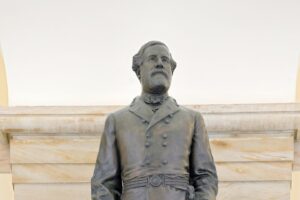State leaders are seeking public input on what individual should replace a statue of former Confederate Gen. Robert E. Lee located in the U.S. Capitol Building in Washington D.C.. A commission appointed by the state legislature will hold a virtual public hearing Tuesday to help determine a replacement.
The Lee statue is one of two that represent Virginia in the U.S. Capitol. The other is a statue of the nation’s first president and also a Virginian, George Washington. The Lee statue is one out of 13 in a section of the Capitol known as the Crypt. Each of the original 13 colonies is represented by a statue.
Virginia legislators passed a bill in the spring allowing a committee to determine if the statue should be removed and recommend a replacement. The commission decided in the summer to remove the statue and will recommend a replacement in December or when the commission concludes its work.
 A date has not been set to remove the statue, said Randy Jones, public information officer for the Virginia Department of Historic Resources.
A date has not been set to remove the statue, said Randy Jones, public information officer for the Virginia Department of Historic Resources.
The replacement statue must honor an individual that is dead and is a notable historical figure or known for civic or military service, according to VDH. The person must be a U.S. citizen but exceptions will be made for Indigenous people who lived in the nation before it was formed.
Virginia’s Democratic U.S. Sens. Tim Kaine and Mark Warner have called for the removal of the Lee statue in the U.S. Capitol.
“The Lee statue in the Capitol should be replaced,” Kaine said in a statement. “There are many compelling candidates for a replacement statue and [I] have full confidence the commission will pick someone representative of our history.”
Citizens have already suggested possible replacements for the Lee statue in the Capitol that can be viewed on the DHR website. Suggested substitutions include former Virginians, such as:
James Armistead Lafayette, a former slave from Virginia that later became a spy for the Continental Army in the American Revolution.
Dr. Robert Russa Moton, second president of Tuskegee University following the death of Booker T. Washington. The Moton Museum, a National Historical Landmark in Farmville, is named after him.
Maggie L. Walker, a former educator and businesswoman who advocated against racism and sexism. She was the first African American woman to create a bank.
Roger Arliner Young, the first African American woman to receive a doctorate in zoology.
Pocahontas, An Indigenous Virginian and daughter of Chief Powhatan.
A number of people have nominated former Secretary of Defense and Gen. George C. Marshall. Marshall was not born in Virginia but graduated from the Virginia Military Institute.
Jennifer Oh, a Virginia resident who leads Capitol tours said in a letter that she opposes a statue honoring Marshall. She said the understanding behind the removal of the Lee statue is to have a “Virginia representative that symbolizes a life of inclusion.” Oh wrote that Marshall’s career does not reflect inclusion or support of minorities.
The commission will also appoint a sculptor to create the statue with preference given to a Virginia-based sculptor.
Eight members serve on the commission: Edward Ayers, a professor at the University of Richmond; Colita Fairfax, a professor at Norfolk State University, Sen. Louise Lucas D-Portsmouth; Fred Motley, a storyteller and performer; Anne Richardson, chief of the Rappahannock Tribe; Margaret Vanderhye, a former delegate who previously led the Virginia Commission for the Arts; and Del. Jeion Ward, D-Hampton. Julia Langan, DHR director, will serve as a non-voting member.
The public hearing will take place from 9 a.m. to noon. Participants can register to attend or speak at the Virginia Department of Historic Resources website. People can also email suggestions to [email protected] until Nov. 27.
– Joseph Whitney Smith / Capital News Service
A memoriam published in honor of General Lee by The U.S. Capitol Visitor’s Center:
Statue: Robert E. Lee by Edward V. Valentine, Location: Crypt, 1934
Born on January 19, 1807, Robert E. Lee served his state with great devotion all his life. At the United States Military Academy he distinguished himself in both scholastics and martial exercises. He was adjutant of the corps and graduated second in the class of 1829.
As a career officer, he served in posts in Georgia and Virginia and as commander of the light batteries, with General Scott, in the Mexican War. He served as superintendent of the U.S. Military Academy from 1848 to 1852.
When the South seceded, Lee reluctantly resigned from the army, hoping to avoid participation in the war he deplored. However, a sense of duty to his state made him accept command of the Virginia forces.
His successful strategy, his tactical skill, and the confidence of his troops earned him the respect of the Confederate leaders. President Jefferson Davis appointed him commander of the Army of Northern Virginia in May 1862. The next three years demanded all Lee’s strength until he was forced to surrender to General Ulysses S. Grant on April 9, 1865.
Lee was paroled and accepted the presidency of Washington College (now Washington and Lee) in Lexington, Virginia. He served in that capacity from September 1865 until his death on October 12, 1870.

